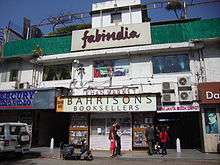Khan Market
Coordinates: 28°36′01″N 77°13′36.5″E / 28.60028°N 77.226806°E

Khan Market (Hindi: ख़ान बाज़ार, Punjabi: ਖ਼ਾਨ ਬਾਜ਼ਾਰ, Urdu: خان بازار), established in 1951 and named in honour of Khan Abdul Jabbar Khan (brother of Khan Abdul Ghaffar Khan), has been ranked as the costliest retail location in India.[1] In 2010, it was rated as the world's 21st most expensive retail high street by real estate firm Cushman & Wakefield[2][3][4] and is consistently ranked as one of the costliest high-end streets.[5][6]
History

Established in 1951, the U-shaped, double-storey market complex originally had 154 shops and 74 flats on the first floor for shopkeepers.[7] Many of these shops were allocated as seed land to immigrants from the North-West Frontier Province after the partition of India. Khan Market is named in honor of Khan Abdul Jabbar Khan, brother of Khan Abdul Ghaffar Khan, by the first traders who set up shops in the market, in appreciation of his efforts in helping them migrate to India safely during the partition. The market is not named for Khan Abdul Ghaffar Khan as is erroneously believed.
Nearby is Sujan Singh Park, New Delhi's first apartment complex, built in 1945, and designed by Walter Sykes George and named after the grandfather of this enclave's most famous resident, writer Khushwant Singh.[8] George also designed, the Ambassador Hotel next door, built in 1945 in a mix of British and Art Deco style. The building is now a heritage property and the hotel has been taken over by the Taj Vivanta chain.[9]
Until the 1980s, all the flats on the first floor continued to serve as homes. Neighbourhood grocery stores and middle-class shops existed in the middle lane, despite the fact it catered most up to upmarket Golf Links, Sundar Nagar, and diplomatic crowd from Chanakyapuri. Gradually, the real estate boom and expanding families of the first generation of occupants forced many families to move out. Thus these homes were sold and started being converted into shops. By the 2010s, only a few families were living in these two-room flats.[7]
A 2011 Cushman & Wakefield survey ranked Khan Market as the world's 21st most expensive shopping street.[7]
Overview
Today it has grown to become one of the most expensive commercial real estate locations in the city. It has a wide variety of stores, including modern showrooms of most of well-known brands, like Nike, Puma, Reebok, Tommy Hilfiger, Benetton, Goodearth and others. Silver jewellery stores Amrapali, Safeera, Silverline, etc., delicatessens, bookstores, paints and hardware stores, electronics, kitchenware, and fabric stores mingle with some of the better restaurants.
Some of the stores and eating joints include FabIndia, Raj stores, Anokhi, Sanjiv Mehra's Allied Stores,[10] Cooptex, Allied Party Xpress, Aamayo, Route 04, The Kitchen, Market Cafe, Cafe Turtle, Albake, Big Chill Cafe, Cafe Zaffiro, Barista, McDonalds, Subway, Kriti Creations, and a general store, National Cloth House and Khadi Gramodyog. The cuisines available at the restaurants include American, Italian, Thai, Mexican, Continental, Malaysian, Burmese, Lebanese & Indian etc.[11]
It is also famous for food including kebabs from Salim's Kebabs, Khan Chacha's Kebab's and momos opposite Lok Nayak Bhavan, which houses several government offices, and a retail market for lighting fixtures on the ground floor. There are several popular bookstores in the market which offer a unique selection in the heart of Delhi.
The market is closed on Sundays.[12]
Location

Khan Market is almost in the heart of the city, close to India Gate. It is surrounded by residential complexes — government owned and private — including Golf Links, Lodhi Estate, Shahjahan Road, Pandara Road, Rabindra Nagar and Sujan Singh Park. Its environs are home to a significant number of bureaucrats from the central government, and famous people like the satiric author Khushwant Singh. It is one of the greenest pockets of the city, very close to the famed Lodhi Gardens. Also in proximity are the India International Centre, the India Habitat Centre, offices of the World Wide Fund for Nature, and other organizations.
Transport
It is serviced by the Khan Market underground station of the Delhi Metro (Violet Line), which lies in front of the colonial-era Ambassador Hotel (now Taj Vivanta).
References
- ↑ Hazlett C., "Glitter and Grit – Shopping Centers Today", February 2007
- ↑ "Delhi's Khan Market is world's 21st costliest high street". The Times of India. 2010-09-23. Retrieved 2010-09-23.
- ↑ "Delhi's Khan Market world's 21st costliest street". The Times of India. 2010-09-24. Retrieved 2010-09-24.
- ↑ "New Delhi's Khan Market India's costliest street, world's 21st". Hindustan Times. 2010-09-25. Retrieved 2010-09-25.
- ↑ Kulshrestha, Taneesha; Tarafdar, Suman (March 29, 2008). "High rentals dwarf luxury brands' India gameplan". The Financial Express. The Indian Express. Retrieved September 15, 2009.
- ↑ "India becomes dearer for high street retailers: Survey". Economic Times. 2010-09-23. Retrieved 2010-09-23.
- 1 2 3 "Home is where the mart is". Mint (newspaper). Jul 13, 2012.
- ↑ "Making history with brick and mortar". Hindustan Times. September 15, 2011.
- ↑ Ambassador Hotel Taj Vivanta.
- ↑ Allied Stores
- ↑ http://www.sodelhi.com/local-markets/807-khan-market-new-delhi
- ↑ Khan Market